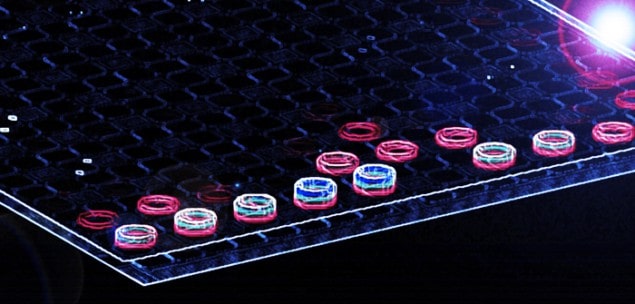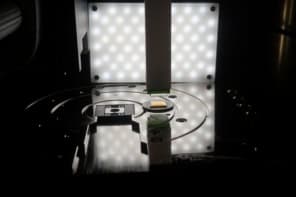
A version of the quantum Hall effect (QHE) involving light rather than electrons has been created by physicists in the US. The team believes the demonstration could boost understanding of the QHE and perhaps lead to the development of better photonic circuits that use light to process information.
The QHE is a well-known phenomenon that occurs when a voltage is applied along a thin conducting sheet and a magnetic field is applied perpendicular to the sheet’s surface. Throughout most of the sheet, the magnetic field makes conduction electrons travel in circular orbits that are quantized. At the edge of the sheet, however, the electrons cannot travel in circles because they would have to leave the sheet and re-enter it. Instead, these electrons hop along the edge in repeated semicircles. Crucially, they will travel along the edge regardless of its shape, following any dents or bulges.
These “topologically protected” paths and other aspects of the QHE have proven to be a rich seam of physics research that has led to two Nobel prizes. However, certain key predictions of QHE theory, such as the presence of bound electron states called anyons, remain unproven. This is because QHE experiments require pure samples, cryogenic temperatures and an ultra-high magnetic field – making measurements difficult to do.
No magnetic field needed
In recent years, physicists have sought mathematically analogous topological edge states that are easier to work with. Systems based on photons rather than electrons have drawn particular interest. However, light is not affected by a magnetic field and therefore researchers need to find another way of bending the photons. The idea of photonic topological states was first proposed in 2008 and first observed in 2009. However, these experiments still required high magnetic fields. Then in 2011 Mohammad Hafezi and Jacob Taylor at the Joint Quantum Institute (JQI) of the University of Maryland and researchers at Harvard University proposed a true photonic topological system that would need no magnetic field. This would allow them, in principle, to be miniaturized for use in microelectronics.
This goal has been realized by Hafezi and colleagues and also by an independent group at the Technion-Israel Institute of Technology and the Friedrich Schiller University in Jena, Germany. The latter group used an array of coupled helical waveguides to make a photonic lattice with topologically protected edge states that could not be scattered by imperfections.
Hafezi, Taylor and colleagues at JQI took a different approach based on a lattice of ring-shaped silicon waveguides placed just nanometres apart, which allow photons to tunnel between them. To create robust topological edge states, the researchers needed something that would have the same effect on photons that a magnetic field has on electrons. This role is played by the phase change acquired by a photon as it travels around a ring-shaped silicon waveguide. “When an electron goes around a magnetic flux it acquires a phase called the Aharanov–Bohm phase,” explains Hafezi. “If I have another particle – even if it’s not charged – that goes around a closed loop and acquires a phase, it looks as though that particle is feeling some magnetic field.”
Neat detours
To confirm the existence of edge states, the researchers injected photons in one corner of the lattice and found that they propagated around the sides to a collection point at the corner. To check the robustness of these states, they removed a ring and watched as the photons made a neat detour around the defect before continuing along the edge – just like a QHE edge state.
Beyond studying the QHE, the researchers believe their work could allow the precise manipulation of photons in circuits, something that is necessary to make optical analogues of electronic components. “There is no specific proposal,” says Hafezi, “but now, with these skills, we have more control on the routing of photons within an array. So we hope that this will give us more knobs to tune and potentially to do logical computation with photons.”
One of the main challenges facing those designing such photonic circuits is that light can easily rebound off any imperfections in a circuit. In a standard waveguide, forward and backward-propagating photons can couple to each other to create a standing wave that prevents photon propagation. In a QHE system, however, the electrons always propagate in the same direction along an edge.
Different phase shifts
The JQI researchers recreated this effect by arranging the waveguide rings so that a photon travelling backwards would acquire a different phase shift than one moving forward. As a result, photons travelling in opposite directions could not couple.
Mordechai Segev, the head of the Technion-Israel team, says time will tell whether the Maryland group’s design or his own will be more useful. He says which one ultimately makes it into technology will depend on which is more easily miniaturized.
The research is published in Nature Photonics.



